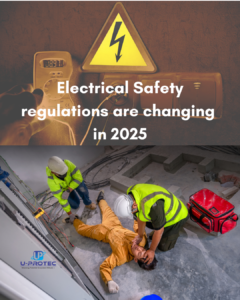how electrical safety regulations are changing in 2025

Introduction
Electrical safety regulations are evolving rapidly to address new technologies, environmental concerns, and increased safety awareness. As we enter 2025, businesses and industries must understand the updated standards to maintain compliance and protect personnel.
This blog covers how electrical safety regulations are changing in 2025, highlighting major updates, implications, and best practices.
Key Changes in Electrical Safety Regulations for 2025
- Stricter Compliance Requirements
Regulatory bodies worldwide are tightening compliance criteria, requiring more rigorous documentation, testing, and certification processes for electrical installations.
- Increased audits and inspections.
- Enhanced reporting standards for safety incidents.
- Emphasis on Renewable Energy Systems
With the growth of solar, wind, and other renewables, regulations now include specific guidelines for integrating these systems safely into existing grids.
- New earthing and grounding standards for renewable setups.
- Updated protocols for inverter and battery safety.
- Adoption of Smart Safety Technologies
Regulations encourage or mandate the use of smart electrical safety devices such as IoT-enabled monitoring systems, automated fault detection, and predictive maintenance tools.
- Real-time system health monitoring requirements.
- Data logging and remote diagnostics compliance.
- Enhanced Worker Safety Protocols
Updated standards emphasize worker safety, especially for personnel working in hazardous electrical environments.
- Mandatory safety training updates.
- Improved PPE (Personal Protective Equipment) standards.
- Stricter lockout/tagout procedures.
- Environmental and Sustainability Considerations
New regulations incorporate environmental impacts, promoting the use of eco-friendly materials and processes in electrical infrastructure.
- Restrictions on hazardous substances in electrical components.
- Guidelines for energy-efficient system designs.
Implications for Businesses and Contractors
- Increased Investment in Training: Staff need up-to-date knowledge on new safety protocols.
- Upgrading Electrical Systems: Older installations may require retrofitting or replacement to meet new standards.
- Enhanced Documentation: Maintaining detailed compliance records becomes critical.
- Collaboration with Certified Suppliers: Partnering with manufacturers adhering to new regulations is essential.
How to Prepare for Regulatory Changes
- Conduct a comprehensive audit of existing electrical systems.
- Implement employee training programs focused on new standards.
- Engage with electrical safety consultants for expert guidance.
- Invest in modern safety and monitoring technologies.
Conclusion
The electrical safety landscape is shifting significantly in 2025, driven by technological advances and heightened safety priorities. Staying informed and proactive about regulatory changes is crucial for businesses to ensure compliance and protect workers.
